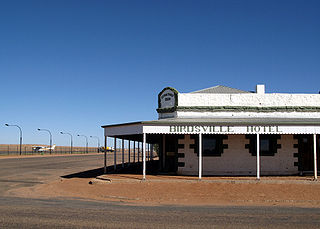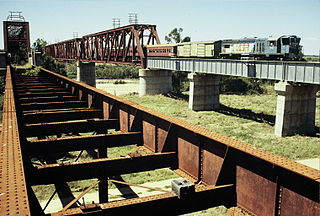
Boulia is an outback town and locality in the Shire of Boulia, Queensland, Australia. In the 2021 census, the locality of Boulia had a population of 314 people.

Birdsville is a rural town and locality in the Shire of Diamantina, Queensland, Australia. The locality is on the Queensland border with both the Northern Territory and South Australia. The town is situated 10 kilometres (6 mi) north of the South Australian border. In the 2021 census, the locality of Birdsville had a population of 110 people.

Cloncurry is a rural town and locality in the Shire of Cloncurry, Queensland, Australia. It is informally known by local people as The Curry. Cloncurry is the administrative centre of the Shire of Cloncurry.

The City of Mount Isa is a local government area in north west Queensland. The City covers the urban locality of Mount Isa, the administrative centre, and surrounding area, sharing a boundary with the Northern Territory to the west.
Kynuna is an outback town in the Shire of McKinlay and a locality split between the Shire of McKinlay and the Shire of Winton in Queensland, Australia. In the 2021 census, the locality of Kynuna had a population of 52 people.
Dajarra and Selwyn Branch Railways were lines in north-west Queensland, Australia. Along with the Mount Cuthbert and Dobbyn Branch Railways, they were essentially built to tap large deposits of copper discovered in the Cloncurry region.

The Great Northern Railway is a 1067 mm gauge railway line in Queensland, Australia. The line stretches nearly 1,000 kilometres linking the port city of Townsville, Australia to the mining town of Mount Isa in north-west Queensland. Along with a passenger service called the Inlander, it is a major freight route connecting the Mount Isa Mines to the Port of Townsville. In 2010, the line moved 5.8 million tonnes of cargo, and this is expected to increase significantly in coming years.

Duchess is a rural town and locality in the Shire of Cloncurry, Queensland, Australia. In the 2021 census, the locality of Duchess had a population of 53 people.
Selwyn is a rural town and locality in the Shire of Cloncurry, Queensland, Australia. Selwyn is now an abandoned mining town. In the 2021 census, the locality of Selwyn had a population of 25 people. See Mount Elliott mine, the Mount Elliott Mining Complex and Mount Elliott Company Metallurgical Plant and Mill links for more information.
Kuridala is a rural locality in the Shire of Cloncurry, Queensland, Australia. It contains the former mining town of the same name. In the 2021 census, Kuridala had a population of 38 people.
Parkside is a suburb of the town of Mount Isa in the City of Mount Isa, Queensland, Australia. In the 2021 census, Parkside had a population of 1,530 people.
Healy is a suburb of the town of Mount Isa in the City of Mount Isa, Queensland, Australia. In the 2021 census, Healy had a population of 1,824 people.

Gunpowder is an outback town and locality in the City of Mount Isa, Queensland, Australia. In the 2021 census, the locality of Gunpowder had a population of 104 people.

Amaroo is an outback locality split between the Shire of Boulia and the Shire of Diamantina, both in Central Western Queensland, Australia. In the 2021 census, Amaroo had a population of 17 people.
Buckingham is an outback locality in the Shire of Boulia, Queensland, Australia. In the 2021 census, Buckingham had "no people or a very low population".

Georgina is an outback locality in the Shire of Boulia, Queensland, Australia. In the 2021 census, Georgina had a population of 21 people.
Sturt is an outback locality split between the Shire of Boulia and in the Shire of Diamantina, both in Queensland, Australia. It is on the border with the Northern Territory. In the 2021 census, Sturt had "no people or a very low population".
Warenda is an outback locality in the Shire of Boulia, Queensland, Australia. In the 2021 census, Warenda had "no people or a very low population".
Mount Isa is a rural locality in the City of Mount Isa, Queensland, Australia. It is the land that surrounds the suburbs of the town of Mount Isa. In the 2021 census, the locality of Mount Isa had a population of 172 people.
Cloncurry–Dajarra Road is a continuous 169 kilometres (105 mi) road route in the Cloncurry local government area of Queensland, Australia. It is a state-controlled district road rated as a local road of regional significance (LRRS). It is a north-east to south-west link between the Barkly Highway and the Diamantina Developmental Road, servicing a number of cattle grazing and production areas in northern Queensland.














